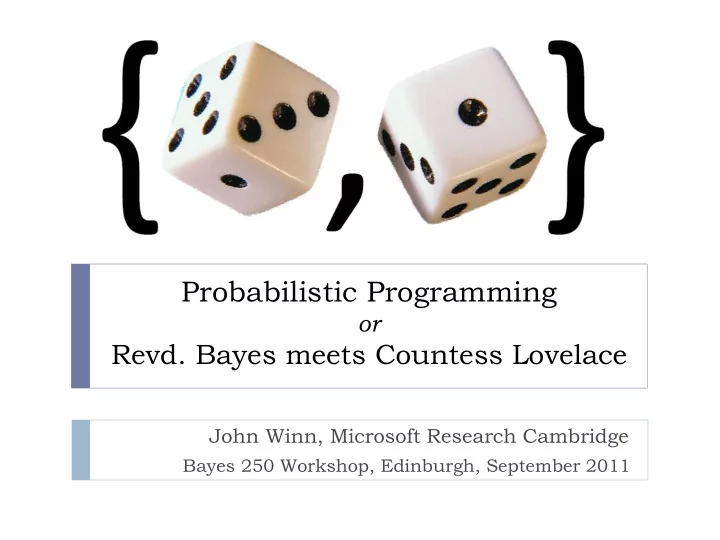

Probabilistic Programming or Revd. Bayes meets Countess Lovelace John Winn, Microsoft Research Cambridge Bayes 250 Workshop, Edinburgh, September 2011
“Reverend Bayes, meet Countess Lovelace” Statistician Programmer 1702 – 1761 1815 – 1852
Roadmap Bayesian inference is hard T wo key problems Probabilistic programming Examples Infer.NET An application Future of Bayesian inference
Bayesian inference is hard ! Complex mathematics ! Approximate algorithms ! Error toleration ! Hard to schedule ! Hard to detect convergence ! Numerical stability ! Computational cost
The average developer… ! ! ! ! ! ! !
The expert statistician ! ! ! ! ! ! !
The expert statistician ! ! ! ! ! ! ! ! ! ! ! ! ! ! ! ! ! ! ! ! ! ! ! ! !
Probabilistic programming Bayesian inference at the language level BUGS & WinBUGS showed the way Three keywords added to (any) language random – makes a random variable constrain – constrains a variable e.g. to data infer – returns the distribution of a variable
Random variables Normal variables have a fixed single value: int length=6, bool visible=true . Random variables have uncertain value specified by a probability distribution: int length = random Uniform(0,10) bool visible = random Discrete(0.8) random operator means ‘is distributed as’.
Constraints We can define constraints on random variables: constrain (visible==true) constrain (length==4) constrain (length>0) constrain (i==j) constrain(b) means ‘ we constrain b to be true’.
Inference The infer operator gives the posterior distribution of one or more random variables. Example: int i = random Uniform(1,10); bool b = (i*i>50); Dist bdist = infer (b);//Bernoulli(0.3) Output of infer is always deterministic even when input is random .
Hello Uncertain World string A = random new Uniform<string>(); string B = random new Uniform<string>(); string C = A+" "+B; constrain (C == "Hello Uncertain World"); infer (A) // 50%: "Hello", 50%: "Hello Uncertain" infer (B) // 50%: “Uncertain World", 50%: “World"
Semantics: sampling interpretation Imagine running the program many times: random (d) samples from the distribution d constrain (b) discards the run if b is false infer (x) collects the value of x into a persistent memory If enough x’s have been stored, returns their distribution Otherwise starts a new run
Bayesian Model Comparison (if, else) bool drugWorks = random new Bernoulli(0.5); if (drugWorks) { pControl = random new Beta(1,1); control[:] = random new Bernoulli(pControl); pTreated = random new Beta(1,1); treated[:] = random new Bernoulli(pTreated); } else { pAll = random new Beta(1,1); control[:] = random new Bernoulli(pAll); treated[:] = random new Bernoulli(pAll); } // constrain to data constrain (control == controlData); constrain (treated == treatedData); // does the drug work? infer (drugWorks)
Probabilistic programs and graphical models Probabilistic Graphical Program Model Variables Variable nodes Functions/operators Factor nodes/edges Fixed size loops/arrays Plates If statements Gates (Minka & Winn) Variable sized loops, Complex indexing, jagged arrays, mutation, No common equivalent recursion, objects/ properties…
Causality bool AcausesB = random new Bernoulli(0.5); if (AcausesB) { A = random Aprior; B = NoisyFunctionOf(A); } else { B = random Bprior; A = NoisyFunctionOf(B); } // intervention replaces above definition of B if (interventionOnB) B = interventionValue; // constrain to data constrain (A == AData); constrain (B == BData); constrain (interventionOnB==interventionData); // does A causes B, or vice versa? infer (AcausesB)
Infer.NET Compiles probabilistic programs into inference code (EP/VMP/Gibbs). Supports many (but not all) infer.net probabilistic program elements Extensible – distribution channel for new machine learning research Consists of a chain of code transformations: Inference Probabilistic T1 T2 T3 program program
Infer.NET inference engine Probabilistic Inference T1 T2 T3 program program A Raining B=1 C D
Infer.NET compiler Probabilistic Channel Inference T2 T3 program transform program A B=1 C D
Infer.NET compiler Probabilistic Channel Message Inference T3 program transform transform program A B C D
Infer.NET compiler Probabilistic Channel Message Inference Scheduler program transform transform program A B Schedule C D
Infer.NET architecture Probabilistic ---------------- Observed values ---------------- ---------------- program (data, priors) ---------------- ---------------- ---------------- ---------------- Infer.NET Inference Engine Infer.NET C# Algo- Algorithm compiler C# compiler rithm execution Probability distributions
Application: Reviewer Calibration [SIGKDD Explorations ‘09] Weak Accept Strong Weak Reject Reject Accept Reviewers Weak Accept Weak Submissions Weak Accept Accept
Reviewer calibration code // Calibrated score – one per submission Quality[s] = random Gaussian(qualMean,qualPrec).ForEach(s); // Precision associated with each expertise level Expertise[e] = random Gamma(expMean,expVar).ForEach(e); // Review score – one per review Score[r]= random Gaussian(Quality[sOf[r]],Expertise[eOf[r]]); // Accuracy of judge Accuracy[j] = random Gamma(judgeMean,judgeVar).ForEach(j); // Score thresholds per judge Threshold[t][j] = random Gaussian(NomThresh[t], Accuracy[j]); // Constrain to match observed rating constrain(Score[r] > Threshold[rating][jOf[r]]); constrain(Score[r] < Threshold[rating+1][jOf[r]]);
Results for KDD 2009 Paper scores Highest score: 1 ‘strong accept’ and 2 ‘accept’ Beat paper with 3 ‘strong accept’ from more generous reviewers Score certainties Most certain: 5 ‘weak accept’ reviews Least certain: ‘weak reject’, ‘weak accept’, and ‘strong accept’. Reviewer generosity Most generous reviewer: 5 strong accepts More expert reviews are higher precision: Informed Outsider: 1.22, Knowledgeable: 1.35 Expert: 1.59 Experts are more likely to agree with each other (!)
Future of Bayesian inference How to make Bayesian inference accessible to the average developer + break the complexity barrier? Probabilistic programming in familiar languages Probabilistic debugging tools Scalable execution Online community with shared programs and shared data + continual evaluation of each program against all relevant data and vice versa. We hope Infer.NET will be part of this future!
research.microsoft.com/infernet
Questions?
Infer.NET now and next Information retrieval Social networks Semantic web Domains Biological Software development Vision NUI Healthcare Natural language User modelling Hierarchical Ranking Collaborative Undirected models filtering models Classification T opic Models models Bayes nets Regression HMMs Object models Factor analysis Sparse Grid models Execution MPI Multicore Azure GPU CPU platform DryadLINQ CamGraph Data size MB GB TB 2008 2009 2010 2011 Future
Recommend
More recommend